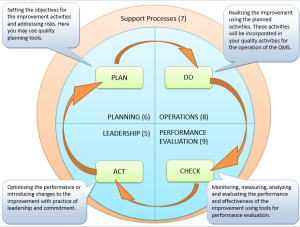The Plan Do Check Act (PDCA) cycle and its relation to the ISO 9001:2015 Standard requirements
The Plan Do Check Act (PDCA) cycle, as much as a lot think, is not related to the CAPA process only. Actually, the PDCA cycle is true to all elements and requirements of a quality management system. The principle of the PDCA cycle can be maintained throughput all all of our daily business aspects. We use it both formally and informally. The PDCA cycle never ends. It is a continual improvement process. Its objective is to maintain the continual improvement. Note: The PDCA cycle is not (!!) one of the ISO 9001:2015 Standard requirements but the standard definitely promotes the approach of the PDCA (Plan-Do-Check-Act) cycle. And it is an efficient tool for achieving its requirements, especially the requirement from chapter 10.3 Continual Improvement.
The Plan Do Check Act (PDCA) cycle history
The PDCA cycle was first developed in the year 1920 by Walter Shewhart. Later it became more popular thanks to our spiritual father W. Edward Deming.
The Plan Do Check Act (PDCA) cycle and the quality management system
The process approach promoted by ISO 9001 systematically identifies processes that are part of your quality system and identifies the interactions between them and may be applied on all processes. Related to the quality management system, the PDCA cycle is a dynamic cycle that could be implemented in each process throughout the organization. It combines planning, implementing, controlling and continual improvement. You may look at it that way – you would achieve continual improvement once you will implement the PDCA cycle. This applies all kind of processes: management’s review, corrective actions, product realization, resource management etc. You can determine implementing the PDCA at the core process, at a minor process or even at several processes together.
Elelements of the Plan Do Check Act (PDCA) cycle
Plan – The planning is combined out of the WH questions:
- What is required to be done? Set the activities needed to achieve improvement
- How much is required to be done? Set the objectives you would like to achieve (which are appropriate to customer requirements and the organization’s policy or objectives)
- Where it is required to be done? Identify processes necessary to implement the improvements
- Who should do it? Allocate resources required to achieve the objectives
- When it is required to be done? Define time frames in which you would like to achieve the improvement
Planning should come after you located exactly where improvement is needed. That means that you should conduct your inquiry before implementing the PDCA process. How do you plan? There is not a defined way for planning. Each organization should plan according to its own environment or nature. But there is one mutual thing to all organizations – the documentation of the plan.
Do – Realize your plan. Put the plan out for the relevant parties for realization. Actually, this is the hard part. Put words into actions. Therefore, try to make the plan as clear as possible, specific as possible or detailed as possible. Divide the objective into reachable targets and these into feasible actions. Maybe even consider writing the plan with the participants themselves so they would come up the appropriate activities. Try to make the DO part easier for them to carry out. In other words for every question presented above (the WH questions) you must deliver the results.
Check – Monitor and measure the processes and the products according to the plan, policies, objectives and requirements. You planned something and you expect results. You allocated resources and performed actions. Now it is time to review the results. Then, report the results. This part is crucial. According to the results you would advance to the next step – Act.
Act – According to the results take measures and activities for improving the performance. Where you are not satisfied with the results – improve! This is the point where you review your plan and improve it. Examine in which parameters your failed to get the achieve objectives and try it with another way. This is the constant improvement. This is the never ending cycle. It could be slowed down, but never rest.
The next diagram presents graphically the PDCA process and its continual cycle (click to enlarge):

PDAC cycle
The PDCA is not a complicated process to implement but to achieve its maximum effect you must conduct it correctly. Like the mentioned above.
Plan Do Check Act (PDCA) cycle – Summary
- The principle of the PDCA cycle could be implemented in all our business aspects. We use it both formally and informally. Its objective is to introduce processes to continual improvement
- The PDCA cycle is not one of the ISO 9001 Standard requirements but promoted by it
- This ISO 9001 Standard process model is actually based on the Plan-Do-Check-Act cycle (PDCA) which can be applied to all kinds of processes
- The PDCA cycle is a dynamic cycle that could be implemented within any process throughout the organization
- Plan – The planning is combined of the WH questions: What is required to be done? How much is required to be done? Where it is required to be done? Who should do it? When it is required to be done?
- Do – After planning you must realize your plan – put words into actions
- Check – Monitor and measure the processes and the products according to the plan, policies, objectives and requirements
- Act – take measures and activities to improve the performance.
This webpage contains only a fragment of the chapter 10 Improvement from the book: ISO 9001: 2015 – A Complete Guide to Quality Management Systems published by:
Why choose the book ISO 9001:2015?
